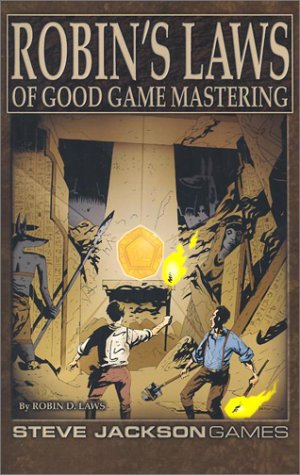RPG Review: Robin’s Laws of Good Game Mastering
To say that Robin’s Laws of Good Game Mastering has been influential in my game mastering style is an understatement. This tiny booklet, by Robin D. Laws, has shaped how I game master since I first picked it up fifteen years ago.
The book states from the start that is not a primer. It’s not going to teach you the basic things you need to know about GMing, won’t talk about things you’ll find in your Dungeon Master’s Guide or Narrator’s Handbook. This book dives deep into the type of thing you’ll usually find in the sequels to those books. Which makes sense, because Robin D. Laws has written DMG2 for both 3.5 and 4th edition, and some of the tips found here appear in
 The book is 33 pages and dives in deep. He begins talking about how to get to know your players, finding out what it is that makes them tick, what they’re looking for in their game. The Player goal chart, which lists players’ emotional kicks would be really useful to hang on your GM screen to keep reminding yourself of what the players need out of a session. This is mainly meant for players who have played together for a while, as you’re not going to know what player type someone is until you’ve played with them for a while. Luckily, he also provides tips for how to spot player types at a glance.
The book is 33 pages and dives in deep. He begins talking about how to get to know your players, finding out what it is that makes them tick, what they’re looking for in their game. The Player goal chart, which lists players’ emotional kicks would be really useful to hang on your GM screen to keep reminding yourself of what the players need out of a session. This is mainly meant for players who have played together for a while, as you’re not going to know what player type someone is until you’ve played with them for a while. Luckily, he also provides tips for how to spot player types at a glance.
The second section deals with choosing a rules set that’s right for your campaign and group: Looking at the theme and tone of a game, power balance and acessibility. He also has another handy chart to help you determine which player type prefers what kind of system on a spectrum of rules crunch. As he says, “There is no one best game system, but there is probably a game system that works best for your group.” I have found this to be true time and time again when I try to shoehorn my group into playing game systems that simply don’t appeal to them. We encountered this recently with Star Trek Adventures which sat uncomfortably on some players.
The Campaign Design section looks at genre, knowing what kind of setting you may want (homebrewed vs prepublished), what is the “mission” of the players (Quote: “You must know and clearly communicate, what it is that the PCs are expected to do.”), and briefly touches on the players’ HQ and recurring cast. This section has proven invaluable to me over the years as I prep a campaign, figuring out exactly how I want to lay out and run a game.
Adventure design is a large section of the book, looking at different adventure structures, including a straightforward railroad adventure (and how to disguise it from looking like a railroad), or puzzle-piece design, where present a structure and let the players follow the interconnected dots and make some of their own to lead the story along.
The book concludes with tips on how to improvise, prep things to make improvising easier, and how to project confidence, mood and focus on the game.
As I said before, this book played a huge influence on my early gaming career, and it’s something I return to regularly to refresh ideas in my head. I highly recommend this to any game master out there, whether you’re new to GMing or have been playing for 20 years.
You can pick up Robin’s Laws of Good Game Mastering here at Steve Jackson Games.

